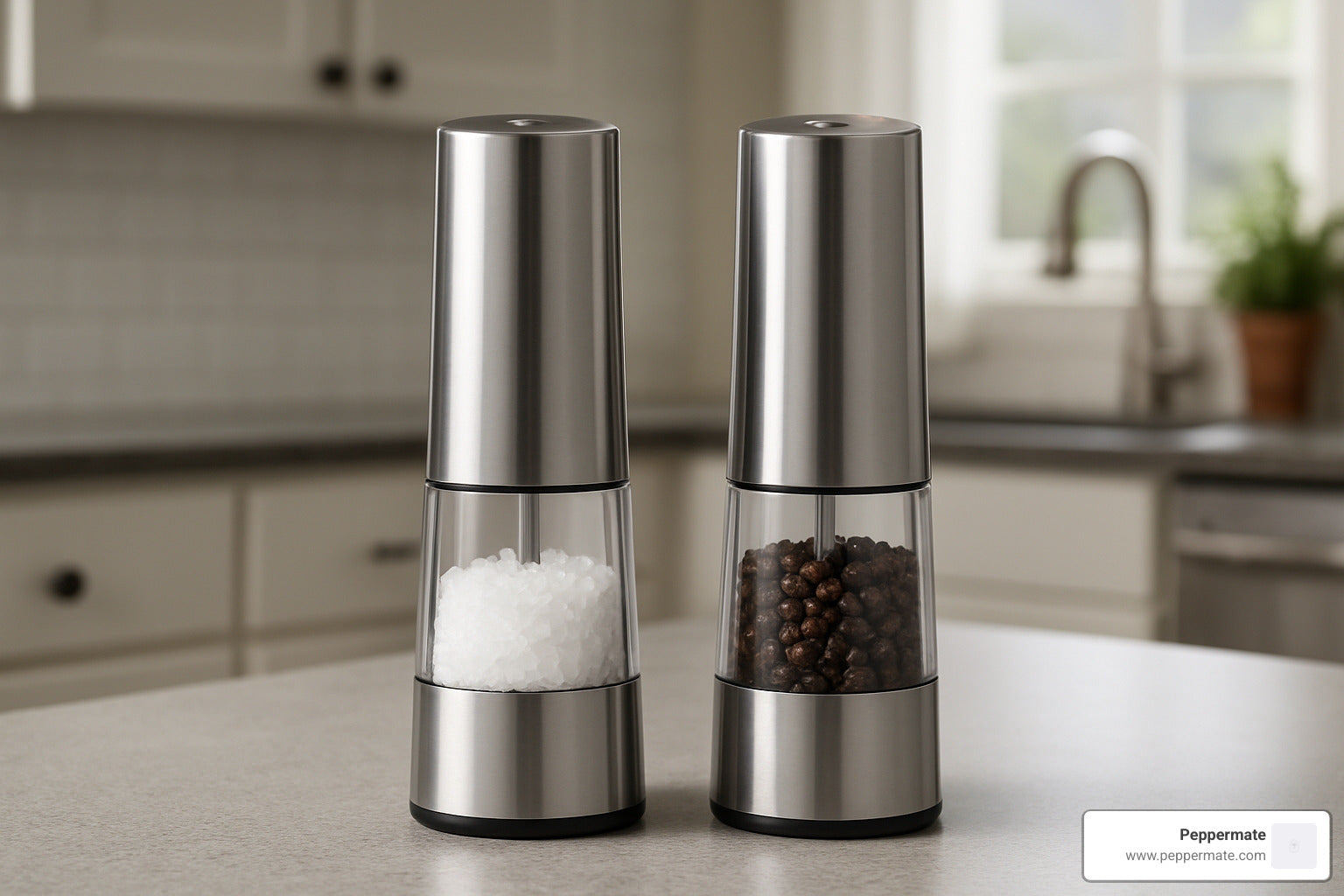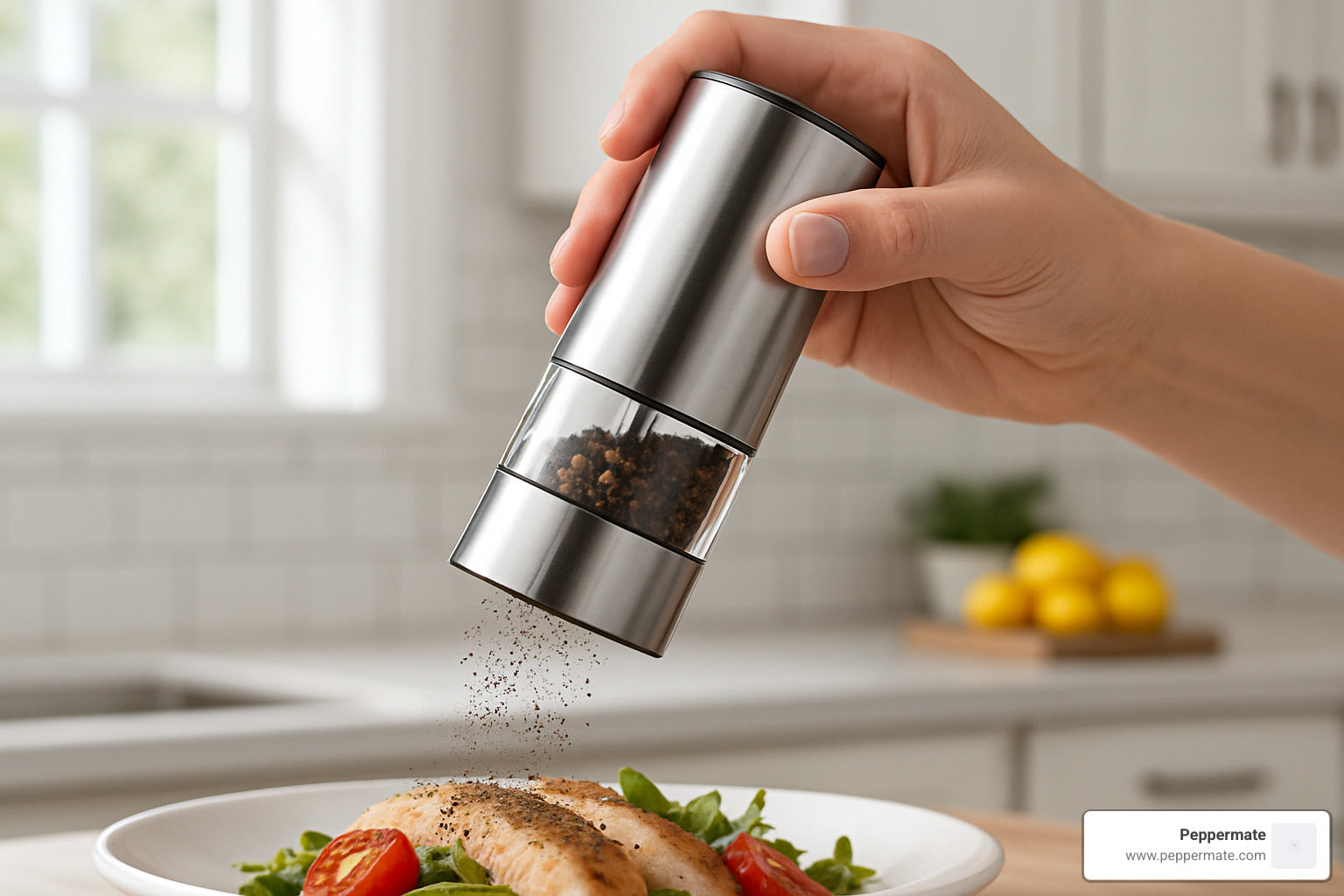Why Fresh Pepper Transforms Every Dish
Pepper mill reviews reveal a simple truth: freshly ground pepper delivers dramatically better flavor than pre-ground alternatives. Based on extensive testing by food experts, here are the top-rated pepper mills for 2025:
Best Overall: Premium Pepper Grinder - $49.95 - 6 adjustable grind settings - Lifetime warranty on mechanism - Clear visibility for refill timing
Best Budget: Affordable Mess-Free Pepper Grinder - Under $30 - Non-slip base catches excess pepper - Easy one-handed operation - Durable construction
Best Electric: Battery-Operated Mill - Interchangeable pods - One-handed grinding with button press - Works with multiple spices - Rechargeable design
Best High-Volume: Professional Pepper Mill - $199 - Grinds 10x faster than typical mills - 40+ grind settings available - Professional-grade output
The science backs this up. When you crack peppercorns fresh, you release volatile oils that evaporate quickly once ground. Pre-ground pepper loses these aromatic compounds within months, leaving you with bland dust instead of the sharp, complex flavors that make dishes sing.
Testing by professional kitchens found that manual pepper mills consistently outperform electric versions for reliability and grind quality. However, electric models shine for one-handed use and convenience during busy cooking sessions.
The key factors separating great mills from mediocre ones include adjustable grind settings, comfortable grip design, easy refilling mechanisms, and durable burr construction. Ceramic burrs last longer than steel, while clear chambers let you monitor pepper levels.
I'm Joseph Rosenblatt PM, a food industry entrepreneur who has spent years testing kitchen tools and developing spice blends for my e-commerce brand. Through countless pepper mill reviews and real-world kitchen testing, I've learned which features actually matter for home cooks versus marketing hype.
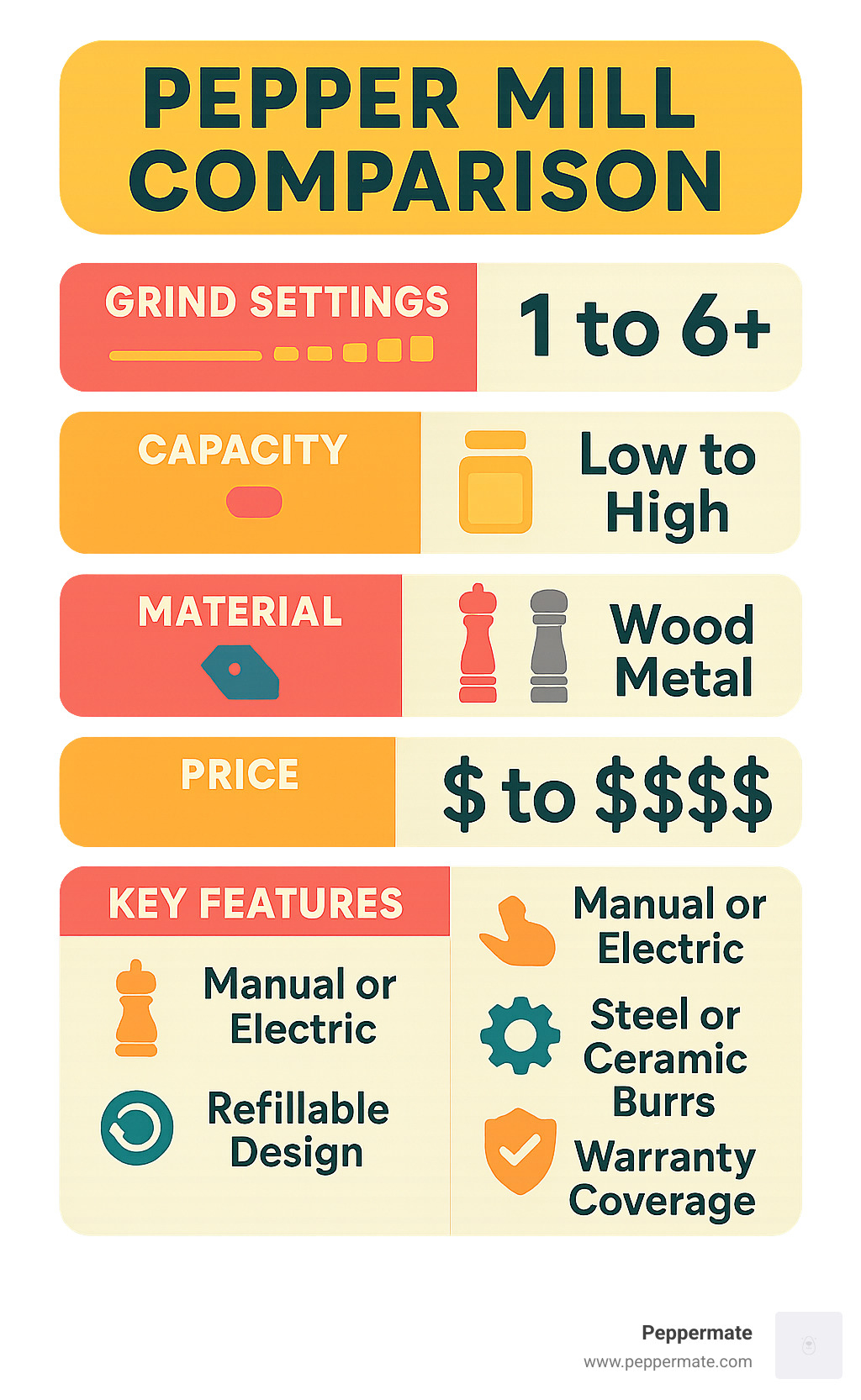
Why Freshly Ground Pepper Packs More Punch
Have you ever wondered why restaurant food tastes so vibrant? A big part of the answer is fresh pepper. Inside every whole peppercorn, essential oils and aromatic compounds stay locked away until the moment you grind. Once exposed to air, those oils start evaporating fast, which is why pre-ground pepper loses much of its punch within four months.
A 2024 review of volatile compounds confirmed that freshly cracked pepper contains far higher levels of piperine and terpenes than shelf-stable powder. In blind tastings, cooks consistently preferred dishes seasoned with fresh grinds —a difference most could identify in a single bite.
How Grind Size Changes Flavor & Usage
- Fine grind: maximum surface area, fast heat release; perfect for smooth sauces or dressings.
- Medium grind: balanced bite and texture; ideal all-purpose seasoning at the stove.
- Coarse grind: slow bursts of flavor as you chew; essential for a steak crust or peppercorn rub.
Pros adjust grind size to timing: fine while cooking so it disperses, coarse at the table so the aroma stays alive. That level of control simply isnt possible with a jar of pre-ground dust.
Types of Pepper Mills & How They Work
Ever wonder what happens inside your pepper mill when you twist that top? It's actually pretty simple – and understanding the basics will help you choose the perfect mill for your kitchen.
Every pepper mill works on the same principle. Two grooved surfaces called burrs rotate against each other, crushing peppercorns that fall between them. Think of it like a tiny stone mill, but designed specifically for spices. The gap between these burrs determines whether you get fine powder or chunky pieces.
Manual twist mills are the classic design you probably grew up with. You hold the bottom steady and twist the top knob. As you turn, peppercorns drop down through the grinding chamber and get crushed between the burrs. Most mills hold between 1-3 ounces of peppercorns, which is plenty for several weeks of cooking.
Ratchet handle mills work differently – instead of twisting, you squeeze a handle that turns the burrs through a clever ratcheting mechanism. It's like using a socket wrench, but for pepper! This design is easier on your wrists and perfect if you have arthritis or just want to grind large amounts without the repetitive twisting motion.
Electric battery-powered mills do all the work for you. Just press a button and a small motor spins the burrs. Some fancy models even have LED lights to illuminate your food (surprisingly helpful when seasoning a dark steak!), while others use gravity sensors that automatically start grinding when you tip the mill over.
The burr material makes a huge difference in how long your mill lasts. Ceramic burrs are the gold standard – they stay sharp up to ten times longer than steel burrs. They're also non-reactive, so they won't rust or affect your pepper's flavor. Steel burrs cost less upfront but may need replacement over time.
| Feature | Manual Mills | Electric Mills |
|---|---|---|
| Speed | Moderate, depends on effort | Fast, consistent |
| Control | Precise grind adjustment | Limited settings |
| Reliability | Very high, no moving parts | Good, battery dependent |
| Maintenance | Minimal | Charging, cleaning |
| Noise Level | Quiet | Moderate motor sound |
| Price Range | $15-200 | $25-150 |
Pros & Cons of Manual Mills
Manual mills are the workhorses of the pepper world. With no batteries to die or motors to break, a quality manual mill can outlast your kitchen appliances. Many pepper mill reviews from professional chefs consistently favor manual models for their rock-solid reliability.
You get complete control over every aspect of grinding. Want just a light dusting? A few gentle twists will do it. Making steak au poivre and need a tablespoon of coarsely ground pepper? Keep cranking until you have exactly what you need. The tactile feedback also tells you when you're running low on peppercorns – you'll feel the difference immediately.
The main downside is the physical effort required. Grinding large quantities can make your wrist sore, especially with cheaper mills that have poor leverage. However, well-designed manual mills require surprisingly little effort for normal cooking needs.
Manual mills also deliver superior grind consistency. Without motor vibration or fluctuating battery power, the burrs maintain steady pressure and create more uniform particle sizes. This means better flavor distribution in your food – no random chunks or fine powder mixed together.
Pros & Cons of Electric Mills
Electric mills shine when convenience matters most. One-handed operation is a game-changer when you're stirring a sauce or holding a plate. Many models include LED lights that actually help you see exactly how much pepper you're adding – no more over-seasoning in dim lighting.
Battery life varies widely between models. Some run for months on standard AA batteries, while rechargeable versions need regular USB charging. The convenience factor is hard to beat, especially for busy home cooks who multitask constantly.
The trade-off comes in complexity and potential failure points. Motors can burn out, batteries always seem to die at the worst possible moment, and all those extra components make cleaning more complicated. Electric mills also tend to be noisier than their manual counterparts.
Interestingly, speed isn't always an advantage. Testing has shown that some electric mills actually grind slower than well-designed manual models. The key is finding an electric mill with a powerful motor and efficient burr design – not all are created equal.
Features Checklist Before You Buy
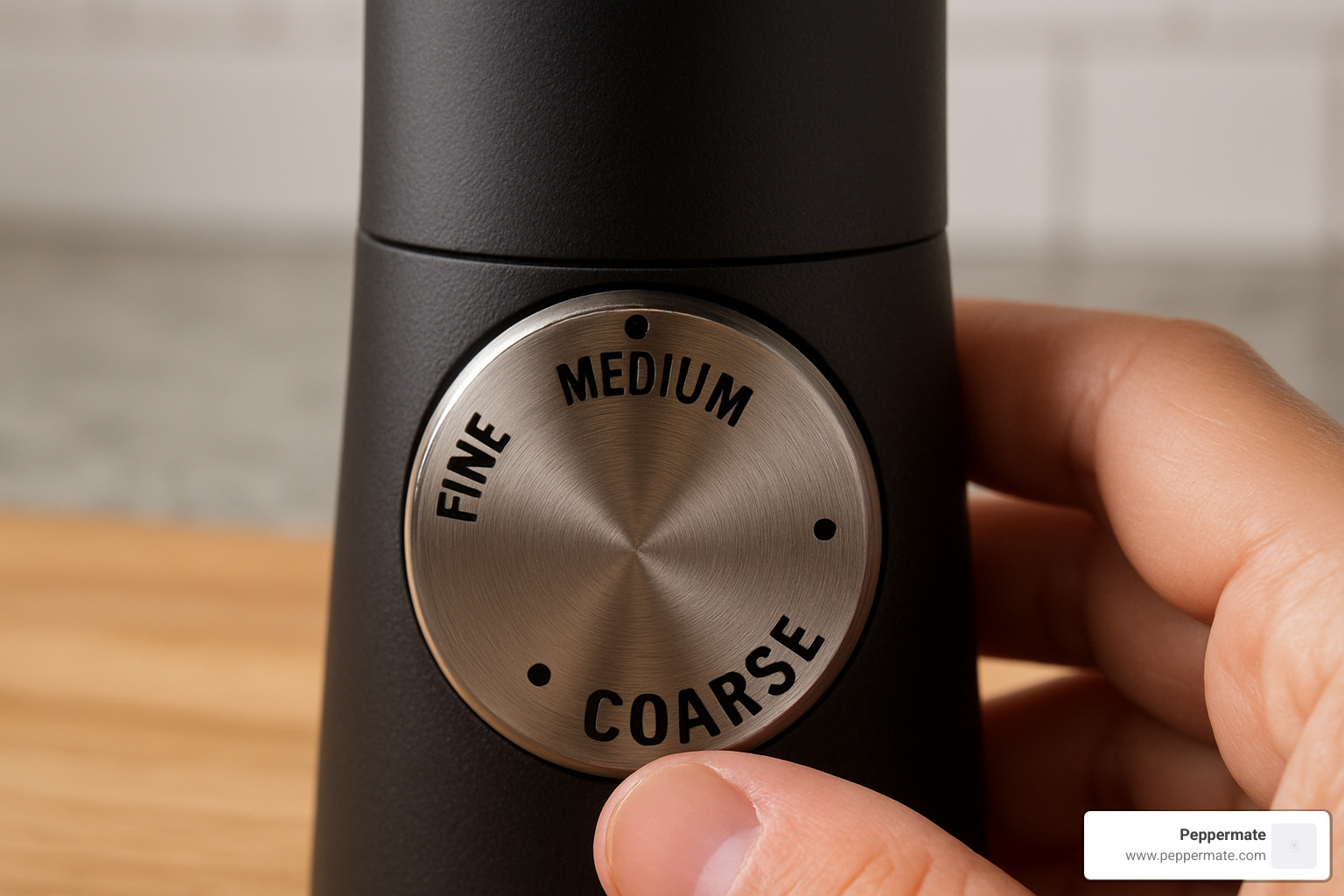
Skip the marketing fluff and focus on six essentials that matter in daily cooking:
- Adjustable grind settings (at least fine, medium, coarse) you can change quickly.
- Comfortable ergonomics so your wrist doesnt ache after a dinner party.
- 2–3 oz capacity, large enough for weeks of use without turning the mill into a club.
- Food-safe materials—ceramic burrs outlast steel and never rust.
- Mess-control features such as non-slip bases or catch trays.
- Easy cleaning & lifetime warranty—signs a maker believes in their mechanism.
Common User Complaints & How to Avoid Them
- Clogging: dont overfill and stick to standard peppercorn sizes.
- Inconsistent grinds: choose ceramic burrs; they stay sharp far longer.
- Slippery grip or loose knobs: look for textured surfaces and solid construction rather than flashy finishes.
Pepper Mill Reviews Roundup 2025 – Best Picks
When combing through this year’s pepper mill reviews, three trends jump out: smarter ergonomics, planet-friendly materials, and better performance at lower prices. Below is a concise look at the standouts—not an exhaustive catalog.

Best Budget-Friendly Choice (< $30)
These mills now deliver the consistency that used to cost twice as much. Non-slip bases and clear chambers solve everyday hassles, while warranties prove they’re not disposable.

Best for Coarse Grinding (Steak Lovers)
A reinforced burr and wider gap adjustment let these models crank out tablespoons of chunky pepper in seconds—no wrist-workout required.
Best Fine-Grind Performer (Sauces & Soups)
Precision threads hold burr spacing rock-steady, so every twist produces uniform powder that melts invisibly into delicate dishes.
Most Stylish, Table-Ready Mills
Minimalist silhouettes and a rainbow of durable finishes mean you no longer have to hide the mill when guests arrive.
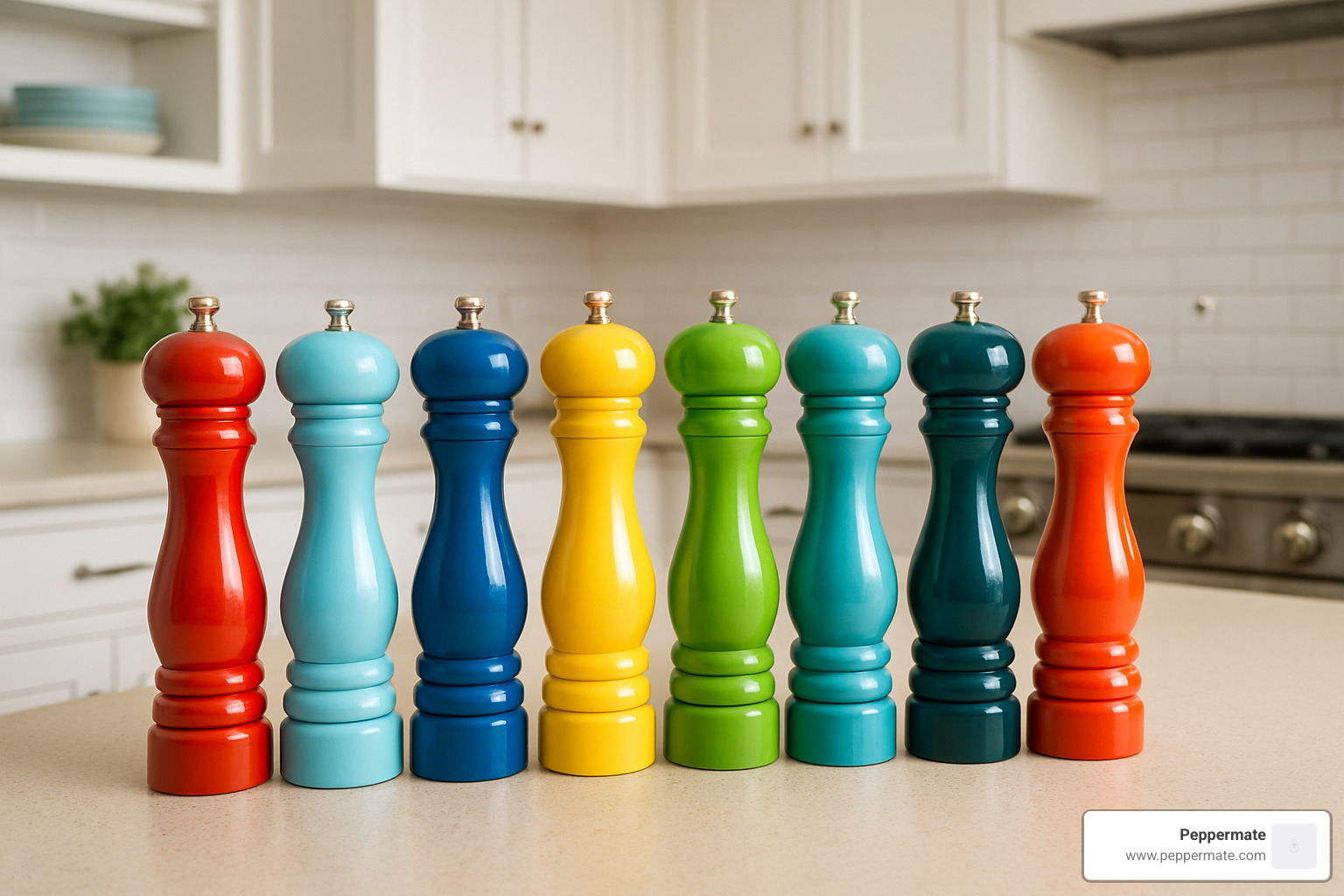
Best One-Handed & Automatic Options
Gravity-activated or button-press designs free your other hand for stirring. Modern USB-rechargeable batteries last weeks between charges and eliminate the AA hunt.
As always, weigh how you actually cook: frequent heavy use still favors a bulletproof manual mill, while multitaskers may prefer the convenience of a well-built automatic.
Care, Cleaning & Multi-Spice Hacks
Taking care of your pepper mill doesn't require a PhD in kitchen maintenance – just a few simple habits that'll keep it grinding smoothly for years. Think of it like your car: a little regular attention prevents big headaches down the road.
Quick refill tips make the difference between a smooth kitchen experience and peppercorns bouncing across your counter like tiny black marbles. The easiest trick? Fold a piece of paper into a makeshift funnel, or keep a small kitchen funnel handy specifically for spice refills. This works especially well with mills that have narrower openings.
Here's a pro tip from my years of testing: refill your mill when it's about one-quarter full rather than waiting until it's completely empty. This prevents the grinding mechanism from running dry, which can cause unnecessary wear on the burrs.
Cleaning your pepper mill properly depends on what it's made from, but the golden rule is simple: less is more. Most mills need nothing more than a quick wipe with a damp cloth on the outside and a dry brush to clear any pepper dust from the grinding chamber.
For plastic and stainless steel mills, you can be a bit more generous with moisture – but never submerge the entire mill unless the manufacturer specifically says it's okay. Wooden mills are the divas of the pepper mill world; they prefer dry cleaning only. A soft brush or dry cloth keeps them looking beautiful without risking damage to the wood.
Drying thoroughly after any cleaning prevents the kind of problems that turn a perfectly good mill into an expensive paperweight. Pay extra attention to the grinding chamber and any adjustment mechanisms where moisture loves to hide. Even a few drops of trapped water can cause corrosion or make your pepper clump together.
Multi-spice trips open up exciting possibilities once you understand what works and what doesn't. Coriander seeds grind beautifully and add a lovely citrusy note to dishes. White peppercorns offer a different flavor profile than black pepper, with more heat and less complexity.
Dried herbs like rosemary or thyme can work in a pinch, but they're better suited for mills specifically designed for softer materials. Avoid anything oily (like fennel seeds) that might gum up the works, and steer clear of super-hard spices that could damage the burrs.
The key to successful multi-spice grinding is knowing your mill's limits and respecting them. When in doubt, stick with peppercorns – that's what these tools were designed to handle best.
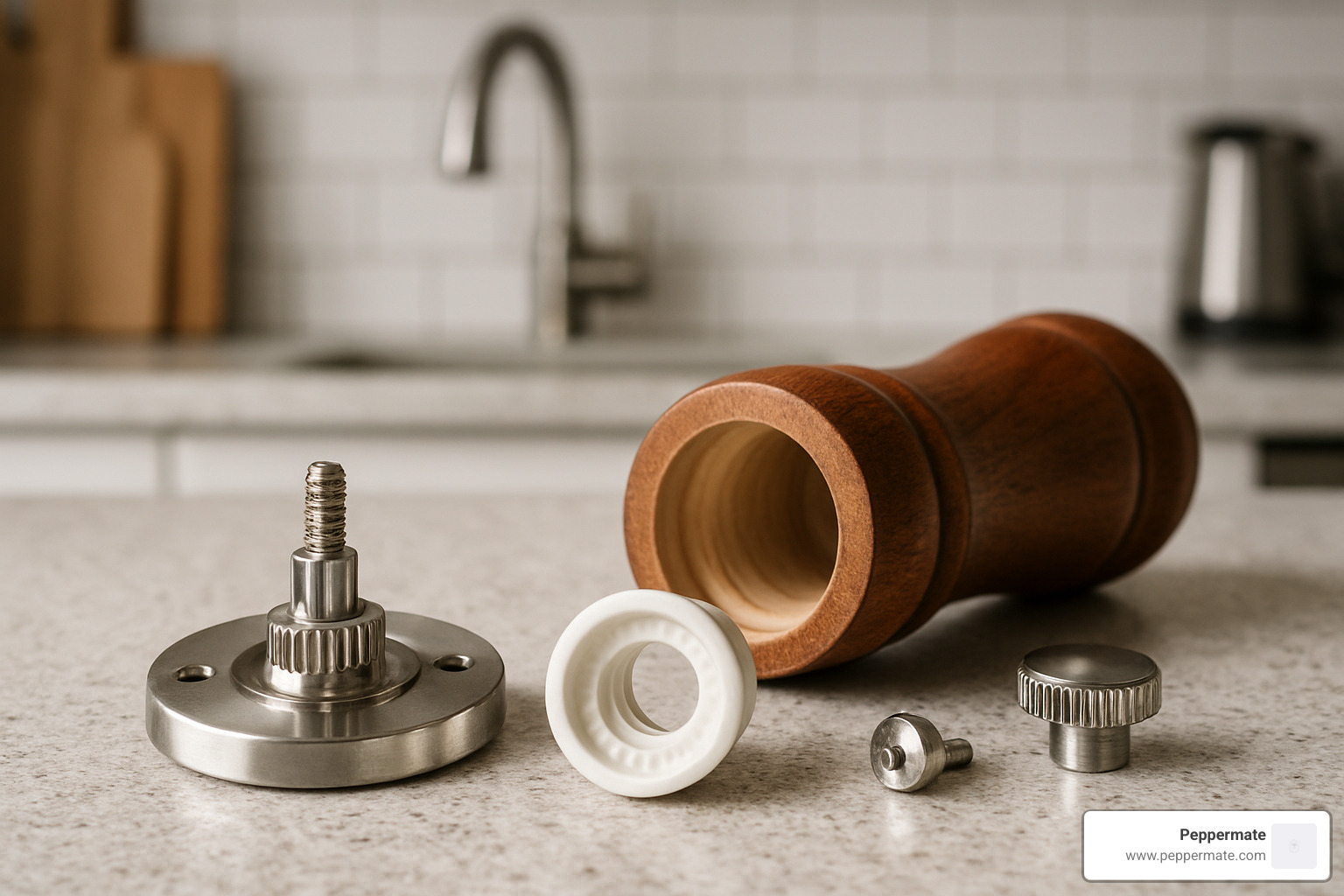
Frequently Asked Questions about Pepper Mills
Let's tackle the most common pepper mill mysteries that home cooks face. These questions pop up repeatedly in pepper mill reviews and cooking forums, so you're definitely not alone if you've wondered about these things.
Why does my mill get jammed?
Nothing's more frustrating than a stuck pepper mill right when you need it most. The good news? Most jams happen for predictable reasons that are easy to avoid.
Overfilling is the biggest culprit. Your mill needs breathing room for peppercorns to move freely through the grinding chamber. Fill it only about three-quarters full, even though it feels wasteful to leave that space empty.
Wrong spice sizes cause major headaches too. Those fancy five-peppercorn blends often contain allspice berries that are simply too big for standard mill mechanisms. They wedge themselves in there like a cork in a bottle. Stick to regular black peppercorns or verify that blends contain only appropriately-sized pieces.
Moisture turns peppercorns into sticky clumps that jam up the works. This happens in humid kitchens or if you accidentally get water inside the mill during cleaning. Store your mill in a dry spot and never submerge it unless the manufacturer specifically says it's waterproof.
When a jam does happen, try this simple trick: flip the mill upside down and grind a few times. This often pushes stuck particles through the mechanism without requiring disassembly. Think of it as giving your mill a gentle shake to get things moving again.
Can one grinder handle salt and other spices?
This question trips up lots of home cooks, and the answer isn't straightforward. Traditional pepper mills and salt don't mix well - literally. Salt corrodes steel grinding mechanisms faster than you'd believe, turning your trusty mill into expensive junk.
The culprit is salt's corrosive nature. It eats away at steel burrs and metal components, causing permanent damage that no amount of cleaning can fix. Even stainless steel isn't immune to salt's destructive power over time.
Ceramic mechanisms offer better salt resistance, but you still need to be careful about other metal components in the mill. The adjustment mechanisms and springs can still corrode even if the burrs survive.
For other spices, size matters more than chemistry. Coriander seeds work beautifully in pepper mills because they're similar in size and hardness to peppercorns. White peppercorns are obviously perfect too, giving you different flavor profiles from the same tool.
Avoid anything significantly larger or harder than peppercorns. Cardamom pods, star anise, and whole nutmeg will jam most mills. When in doubt, compare the spice size to a peppercorn - if it's noticeably bigger or feels much harder, find a different grinding method.
Are expensive mills worth it for home cooks?
This might be the most hotly debated question in pepper mill reviews, and honestly, the answer depends entirely on how you cook.
Daily pepper users absolutely benefit from investing in quality mills. If you're grinding pepper every day for cooking and seasoning, superior ergonomics prevent hand fatigue, better mechanisms provide consistent results, and durable construction means you won't be shopping for replacements every few years.
Premium mills offer features that matter when you use them regularly: lifetime warranties that actually mean something, precision adjustment mechanisms that stay calibrated, and comfortable grips that don't strain your wrists during extended use.
But here's the thing - occasional users can get fantastic results from well-designed budget options. If you grind pepper a few times a week for basic seasoning, a thoughtfully engineered affordable mill will serve you perfectly well.
The key is matching features to your cooking style rather than chasing the highest price tag. A mill with adjustable settings, easy refilling, and reliable mechanics will transform your cooking regardless of what you spend. Focus on those fundamentals, and you'll be happy with your choice whether it costs thirty dollars or two hundred.
The most expensive mill in the world won't help if it sits unused in your drawer. Choose something you'll actually enjoy using, and your food will taste better for it.
Conclusion
After testing dozens of mills and reading countless pepper mill reviews, one thing becomes crystal clear: freshly ground pepper transforms ordinary dishes into extraordinary ones. The difference isn't subtle – it's the kind of flavor upgrade that makes you wonder why you ever settled for pre-ground dust.
Your perfect pepper mill depends on how you actually cook. If you're grinding pepper multiple times daily, investing in a premium manual mill with ceramic burrs makes perfect sense. The reliability and precision will serve you for decades. But if you're an occasional cook who values convenience, a well-designed electric model might be your best friend.
The most important lesson from our research? Don't get caught up in fancy features that sound impressive but don't improve your cooking. Focus on what matters: consistent grind quality, comfortable grip, easy refilling, and durable construction.
At Peppermate, we've spent years perfecting these fundamentals. Our patented side handle design gives you better leverage than traditional twist mills, making grinding effortless even for large quantities. The adjustable ceramic mechanism delivers precise control from fine powder to coarse chunks, while our clear base lets you see exactly when it's time to refill.
We stand behind our mills with a lifetime warranty because we know they're built to last. Whether you're seasoning a quick weeknight pasta or preparing an elaborate dinner party, your Peppermate mill will deliver consistent results year after year.
The versatility extends beyond pepper too. Our mills handle coriander, white pepper, and other spices beautifully, making them true multi-purpose tools rather than single-use gadgets.
From our locations in New York and Sydney, we're proud to serve home cooks who refuse to compromise on quality. Every mill reflects our commitment to combining reliable performance with thoughtful design.
Ready to taste the difference that freshly ground spices make? More info about spice grinder warranty and find how Peppermate can lift every meal you create.


